Decision Review System
Agrima Kumar1, Lavanya Praphul Kunder2, Jonathan Josh Mathew3, Rishikesh Umesh Patil4 , Asst. Prof. Dakshayani R.5
1, 2,3,4 UG Student, Dept. of Computer Engineering, Fr. Conceicao Rodrigues Institute of Technology, Vashi, Maharashtra, India
5 Assistant Professor, Dept. of Computer Engineering, Fr. Conceicao Rodrigues Institute of Technology, Vashi, Maharashtra, India ***

Abstract - A fair decision is crucial in any sport to give justice to the game. Any wrong decision due to human misperception may fate the result of the game. Computer vision and Image processing techniques use multiple cameras for demonstration. This project focuses on a system which helps in making the decisions to assist the umpire in taking the decisions such as determination of winner in a race, not out/out in cricket, foul or goal in football etc. with just the help of smartphone camera of goodquality.
The DecisionReview System(DRS)which is tobedeveloped inthisprojectaimstogivedecisionslikerun outandstump out. Tkinter will be used to develop the Graphical User Interface (GUI) of DRS. Tools such as OpenCV library, Python Imaging Library, Imutils will be used for the implementation.
Key Words: Tkinter Library, OpenCV library, Python ImagingLibrary,Imutils
1. INTRODUCTION
Withtechnologytakingovereveryaspectoflife,itwasonly amatteroftimebeforeitwasutilizedtotheadvantageof sports. Technology in sport is used with an objective to eliminate human errors that may have earlier affected the course of the game drastically. The Decision Review Systemwas introducedacross various sports,to givethe playersanopportunitytoreviewsucherrorsfromtheon fieldumpire.Thisprojectidentifiesandexaminestheuse of officiating technology and it impact across different sports such as badminton, rugby, tennis and cricket [1]. In addition to this, statistics collected within various sports have proved time and again that umpiring decisionshavebeenmoreaccuratewithDRSthanwithout. ItissillytoarguethatweshouldnothaveDRSunlessithas 100%accuracy youanywaycannotget 100% accuracy withoutusingtechnology.ItisenoughthatDRSimproves theaccuracypercentage asitdoubtlesshas,from90.3% to 95.8% for there to a strong case for its use. Furthermore,theDRSalsohasotherthingsgoingforit.As theGuardian’sRobSmythehaspointedout,itischanging the game in some fundamental ways, and definitely for the better. It has made the game even more competitive andfair.[3]
1.1 Background
Technology within sports is forever advancing due to the evolvingworldthatistoday.Thetechnologyi.e.,DRS assistsmatch officials to make the correct decision in a gamethathas the potential tochangethe final outcome of that game/match. The first use of a decision review system withinsportstookplaceintheNFLasfarbackas 1985.Theyusedinstantreplaytechnologytomonitorthe gameinsidethestadiumtoallowtheofficialstobemore accurate and also add another dimension to officiating. However, this technology held many bugs and often caused delays, as wellas only being able to review an incident with indisputable visual evidence. This technology was the birth of decision review systems used in the modern day. Majority of sports have developed and evolved over the last decade by implementing this type of technology to advance the sport itself. These technologies are able to improve the athletes’ performance by thoroughly analysing their performance, produce optimum sportswear to give athletes an advantage,improve the refereeing decisions usingdecisionreviewsystems.[2]
1.2 Aim and Objective
OuraimistocreateaDecisionreviewsystem(DRS)with theobjectiveofeliminatingthehowler thepoordecision takendue to nuances missed with the naked eye, which with assistance of this technology can be avoided. Our projectwillprovideaidwithdecisionslikerun out,stump out,net cross,declaringawinneretc.Tkinterwillbeused to develop the GraphicalUserInterface(GUI)ofDRS.To detect the decisionor occurrence of event of the sport from the video we will beoptimizing and using various functions such as frame subtraction using an inbuilt pythonmodulecalledOpenCVlibrary.[4]
International Research Journal of Engineering and Technology (IRJET) e ISSN: 2395 0056

Volume: 09 Issue: 05 | May 2022 www.irjet.net p ISSN: 2395 0072
2. LITERATURE SURVEY
2.1 Umpire Decision Review System in Cricket
Thispaperaimstoproduceaverycosteffectiveand
affordable computer mechanism that supports and facilitatesthe cricket umpire, runs at a low budget, has lower technical(software and hardware) requirements, and can be used incricket tournaments at local district level, this indeed will train the network as well as improve the efficiency of the game from a grass root level.
The module uses tools like Python, Tkinter for GUI, Pillow, OpenCV and Imultis packages for Python. In this project specifically, live feed of the instance can be fed through thecamera as an input stream for the software and thus decisions can be carried out in an instance, for theliveaudience.Ultimatelysavingprecioustime.
Withoutanyfancyequipmentandwiththehelpofjusta computer system and a camera this system can run efficiently, thus making it compatible for all scale tournaments. This project is only an infant and there is always room for various kinds of improvement and modifications.[5]
2.2 Goal detection in football by using Support VectorMachines for classification
In the proposed paper focus is primarily based on the problem of detecting 3D objects by using the image which theyprojectonthesensing planeofacamera.The occurrenceof the event is established detecting the ball andcomparingitspositionwithrespecttothelocationof thegoalpostinimage.
Inthefirsttestbatchthedetectionratewasof98.3%with afalse positive rate of 0.2%; in the second test batch, where occluded footballs were considered too, the detection rate was observed to be 76.2% with a false positiverateof2.6%.Aparticularinstance of this general problem is the detectionofa ball in images at theaim of detectinggoalsduringafootballmatch.Thesystemcanbe seenasanelectroniclinesmanwhichhelpstherefereeto establishwhetheragoalhasoccurredornot.[6]
2.3 Use of Technology in Tennis, Football and Cricket
ThispaperproposestheideaofLineReviewSystemused inHawk Eyeballtrackingsystemsintennis.Ineachframe sentfromeachcamera,thesystemidentifiesthegroupof pixelswhichcorresponds to theimage of the ball.Itthen calculates for each frame the position of the ball by comparing its position on at least two of the physically separatecamerasatthesameinstantintime.Asuccession
of frames builds up arecord of the path along which the ball has travelled. It alsopredicts the future flight path of the ball andwhereit will interact with any of the playing area features already programmedinto the database. The system can also interpret these interactions to decide infringementsoftherulesofthegame.
Although, of all the challenges made by the players that have been created, succeeding rulings made by the Hawk Eye system have shown that only 46% of the decisions made arecorrect. French Open have thus far refused to use this technology, as the unique characteristicsoftheclaycourt doesn’twarrantit.Every ball played in the match will make amark on the clay surface,itis possiblefor the matchofficialtoget outand havealookattheplacewheretheballwasstrucktowork out if the ball was in or out, therefore avoiding the necessityofhawkeye.
While the Football version of the system has substantially trailedandhas performed effectivelyinthe testenvironment.TheHawk Eyesystemthere,usesthree cameras targeted onevery goal line, and each of them takevideofootageat600framespersecond.Thus,ithas means to grant a conclusivedecision on whether the footballhasfullycrossedthegoallineornotandtransfer thisinformationtothemainrefereelessthanonesecond. [7]
2.4 Decision making using image processing
This paper proposes a new approach for detecting the runoutusingstumpdetectionandfromtheintersection ofthebatandthecreaseline,namedArtificialIntelligent third Umpire(AITU). Theaccuracyofdecisionmaking is improvedtherebyreducingthethirdumpirework.
If the on field umpire within a fraction of a second was not able to make a decision, then the decision from the third umpire is sought. Then the third umpire views various TV replaysatvariousanglesandwilldeclarethe resultas‘out’or‘notout’.Iftheumpiresarenotsureabout the decision that abatsman is ‘out’ or not, as they are deficient with more convincing evidence, the standard practiceis tosetfreethebatsman,knownas"thebenefit ofthedoubt".However,thismaypossesscertainproblems includingdelayinmatchwhichmayprovetobecritical.
The input to the proposed module is a video. A digital videoencompassesasuccessionofdigitalimagesdisplayed inquickprogression.Thematchvideoisprocessedtoget the frameswhich arethen used for makingthedecision. The foregroundis extracted by performing background subtraction. Initiallypre processing is done to enhance the image quality. Frame segmentation is process of changingtherepresentationoftheimagetomakeiteasier for analysis. It is done on video frames to locate object boundaries like lines, curves, etc.
Volume: 09 Issue: 05 | May 2022 www.irjet.net p ISSN: 2395 0072

While the following system proves to be an accurate modeltoprovide decision for run out without human intervention,unfortunatelythesamecannotbesaidfor decisionsuchasLBWdetectionandCatchdetection.[8]
2.5 Public understanding of technology with special reference to Hawk Eye
This paper aims to introduce the DRS and especially Hawk Eyefortheunderstandingofthepublic.Itprovides aninsighttoHawk Eye,whichisavideoprocessingsystem combiningseveral cameras and a computer to store and process the data. By combining thetrajectory ofthe ball withthemodelofthepitchandthedatabaseofrules,the path of the ball can be reconstructed against the background of the main featuresofthe playing area as a virtual reality and the decision is given The reconstruction of which can be shown to television viewers.
It also talks about DRS as a decision aid to the umpire ratherthandecision maker for theumpire as well as the AutomatedDecision Principle. If it were followed, and with the increasing speed of computation potentially making automated decision devices more accurate and morecapableof analyzing and presenting, in real time, the magnitude of uncertainty associated with any reconstruction,thefutureforthe technology as an aid to humanjudgment,seemsbright.[9]
2.6 Decision Review System in Cricket
This paper suggests that the most common instances of referrals are for caught behind and Leg Before Wicket (LBW).Asthefinaldecisionridesonchanceofagreement of the fieldumpire along with, the DRS algorithms since thistechnologypredictsthenatureofthetrajectoryofthe delivery and such factors are dealt in very small measurements (in millimeters).Various errors included may change the final result for the same delivery if replayedagain.Thepaperputforththemainideathatisto have a continuous real time feed clicked from the six cameras strategically placed in the stadium each operating at the specific frame rate which is enough to capture the pitched delivery to provide data points for mapping the virtual trajectory of the ball. Though, there is always a question of the accuracy with which the technologyworksasitsdecisioncannotbereferredagain and is considered final. Hence, the accuracy of the technology usedis limited to a certain range, but along withthehumaninterventioninthedecisionmaking,this reviewsystemisboundtobetheperfectsolutiontosuch aproblem.[10]
3. EXISTING SYSTEM
3.1 Decision Review system in Cricket
The decision review system in cricket comprises of various components such as Hotspot, Hawk Eye, Snickometer,Ultra Edge, etc. For the Hawkeye, the main goal is to have a continuous real time feed clicked from the six cameras strategically placed in the stadium each operating at the specific frame rate which is enough to capture the pitched delivery to provide data points for mapping the virtual trajectory of the ball. The third umpire refers to this technologywhenareferralforaLBWissentupstairsto verifywhethertheballwasgoingontohitthestumpsif notinterruptedbythebatsmenleg.


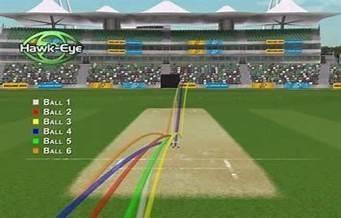
3.2 Decision Review system in Tennis
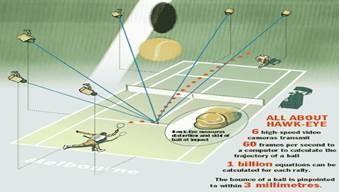
All Grand Slam tournaments of tennis provide line review system which uses Hawk Eye ball tracking system. The players can use this system to evaluate debatable line calls.All Hawk Eye systems are based on the principles of triangulation using visual images and timing data providedby a number of high speed video cameraslocatedatdifferentlocationsandanglesaround the area of play. The tennishawkeyesystemusesupto ten cameras. The system rapidly processes the video feedsfromthecamerasandballtracker.Thesystemuses something called data storewhichis used to store a 3D blue print model of the playing area/ court and also storedinitaretherulesofthegame.
3.3 Decision Review System in Football
Decision Review system in Football comprises of various systems such as smart ball system, Goal Ref System,HawkeyeSystem,etc.Thesystemwhichhashad
International Research Journal of Engineering and Technology (IRJET) e ISSN: 2395 0056

Volume: 09 Issue: 05 | May 2022 www.irjet.net p ISSN: 2395 0072

a very successful trial and is the leading candidate out of all the other system is the Hawkeye system. Primarily used in the English Football league, Premier League the Hawk Eye system uses three cameras targetedoneverygoal line,andeachofthemtakevideo footage at 600 frames per second. Hawk Eye has the means to grant a conclusive decision on whether the football has fully crossed the goal line or not and transferthisinformationtothemainrefereeinlessthan asecond.

WindowsandmacOSinstallsofPython.
4.2 Frame Subtraction:
Frame subtraction will be done using OpenCV (Open Source Computer Vision Library) which is a library of programming functions mainly aimed at real time computer vision. OpenCV is an open source library which is very useful for computer vision applications such as video analysis, CCTV footageanalysis andimage analysis.OpenCVsupportsawidevarietyof programming languageslikePython,C++,Java.Itcanprocessimagesand videostoidentifyobjects,faces,oreventhehandwritingof a human. OpenCV is written by C++and has more than 2,500optimizedalgorithms.Whenwe
4. PROPOSED SYSTEM
Traditionally, in various sports the final judgement is givenby the referee or the umpire. While usually most of these decisions are correct, often there are discrepancies behind these decisions since human judgementisinvolvedwhichhasthepotentialtochange the final result of the game. OurSystem is basically an aidtotheumpireincaseofsuchdiscrepancieswherein onlyagoodqualitycamera anda systemtooperatethe software is needed. What this human aid does is, it operatesonframeratetogiveaclearpictureoftheexact momentwherethedecisionneedstotakeplaceand the final call is given by the referee themselves.
For the module:
Our project will be implemented using Python and Tkinter, OpenCV library, Python Imaging Library, Imutils,Pillowmoduleetc.Decisionslikestumpout,run out etc. canbe decided by altering the source video’s frame rate for thewhich, we will be optimizing and usingframesubtractionusingOpenCVlibrary.
4.1 GUI of DRS:
Tkinter is used to make GUI of the Decision Review Systemandvariouscomputervisonalgorithmsthatgive decisions based on different criteria. Python offers multiple options for developing GUI (Graphical User Interface).OutofalltheGUImethods,Tkinteristhemost commonly usedmethod.Beinga Python binding to the TkGUItoolkit,itgivesstandard Pythoninterfacetothe Tk GUI toolkit, and is Python's de facto standard GUI. Tkinter also includes standard GNU/Linux, Microsoft
value:
createapplicationsforcomputervisionthatwedon’twant tobuild from scratch we can use this library to start focusing on real world problems. There are many companies using this library today such as Google, Amazon, Microsoft and Toyota. Many researchers and developerscontribute.WecaneasilyinstallitinanyOSlike Windows, Ubuntu and Mac OS. With reference to our project, OpenCV library will be majorly used to bring changes to the frame i.e., increasing or decreasing the framespeed.
4.3
Python Imaging Library:
Python Imaging Library (expansion of PIL) for which Pillowmodule is to be installed, is the de facto image processing package for Python language. It incorporates lightweight image processing tools that aids in editing, creating and saving images and with respect to our project,itwillloadimagesfromanarray.
4.4
Imutils Module:
Imutils which is basically a series of convenience functionstomake basic imageprocessing functions such as translation, rotation, resizing, skeletonization, and displayingimages easier with OpenCV will also be used fortheimplementation.
Hardware Requirements
i. ACameraofdecentquality
ii. PC Modern Operating System: 32 or a 64 bit Windows7, 10 or 11, Mac OS X 10.11 or higher, 64 bit Linux: RHEL 6/7,64 bit(almostalllibrariesalsoworkin Ubuntu)x8664 bitCPU(Intel / AMD architecture)4GB RAM5GBfreediskspace.
Software Requirements
i. OpenCV Library 32 or a 64 bit computer, Windows 7,10or11,macOSX10.11orhigher,orLinuxRHEL6/7, Python2.7,3.4,3.5or3.6.
International Research Journal of Engineering and Technology (IRJET) e ISSN: 2395 0056

Volume: 09 Issue: 05 | May 2022 www.irjet.net p ISSN: 2395 0072
ii. Tkinter(8.6.11) iii.Imutils Open CV Library, Python 2.7 or3.VisualStudioCodeIDE(1.61.1)
5. DESIGN OF THE SYSTEM
Flowchart1:Approach
In the system, the video will be added according to the timeframe where in the decision making is required. Then the sport is to be selected accordingly following whichadecisionwindowpop upwillappearwherethere will be options to slow or make the video go faster by altering the frame rateand thus it will be decided if the decision made by the umpire is to be sustained or overturned.SystemArchitecture

Flowchart2:BlockDiagramofDecisionReviewSystem
The project has been implemented using tools like Tkinter for GUI, Pillow, and OpenCV. Tkinter is a GUI frameworkthatis built into the Python standard library thathasbeenusedforthefrontend.Forthebackendthe pythonprogramminglanguagehasbeenused.
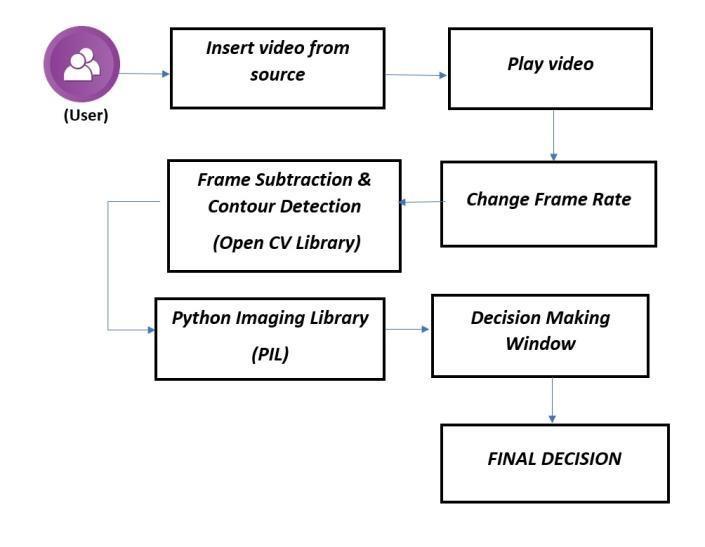
At first the user will be selecting a sport for which the decision has to be made. Then a video will be inserted fromthe source destination. Once inserted we can play the videowith different framerates available. Thiscould bedoneusingvarious modules and tools as mentioned. OpenCVisahugeopen sourcelibraryforvarioussectors which has been primarily used for image processing. It willbeusedtoprocessimagesandvideos.
Further Tkinter also relies on Pillow for working with images. Pillow is basically a fork of the Python Imaging LibraryandcanbeimportedinaPythonconsoleasPIL. It incorporates lightweight image processing tools that aids in editing, creating and saving images. Hence by slowingdowntheframerateacollectivedecision(Human Aided) could bemade. A decision making window will appear which wouldhaveseveral options depending on the sport which had beenchosen earlier and the final decisionwillbedisplayed.
International Research Journal of Engineering and Technology (IRJET) e ISSN: 2395 0056

Volume: 09 Issue: 05 | May 2022 www.irjet.net p ISSN: 2395 0072
6. RESULT AND DISCUSSION
6.1 Observations
Using our application, we have thus created a Decision Review module. While most of the process was done using our application, a variety of images as well as Graphics Interchange Format (GIFs) were developed usingCanva software. It took us 5 6days to figure out a properframeworkforthewholemoduleincludingallthe features which we wanted to implement after studying uponthemodulesandpreviouslydevelopedprojectson the same. Since the libraries used for this project were availablewithinpythonandonlyrequiredustoimportor needed to be imported from modules which were installed using pipinstallcommand,madeiteasier and a less of a pain stakingprocess when it came to libraries. Online tutorials are available on how to do this. Regardless,ourprocessinvolvedthefollowingsteps:
6.1.1 Development of GUI
For the development of Graphical User Interface (GUI) we used the Tkinter library of python in which around 18 windowswerecreatedcateredtospecificfunctionsin whichthebreakdownisasfollows:
TheStartingWindowfollowedbySelectSportwindow. Theselectsportwindowcomprisesofthreesports:
Football: Football → Upload Video → main decision window frames are altered → Choose Decision → GIF pop up window→Displayofdecision
Athletics: Athletics → Upload Video → main decision window framesarealtered→GIFpop upwindow(SinceDecision hastobegivenmanually)
Cricket: Cricket→UploadVideo→maindecisionwindowframes arealtered → Choose Decision → GIF pop up window → Displayofdecision
Following which appropriate images and GIFs were developedonCanvaforbackgroundaswellasbuttons.


6.1.2 Creation and Association of Callback Function
ButtonsarestandardwidgetsinaGUI.Theycomewith thedefaultTkintermoduleandcanbeplacedinthe window.APythonfunctionormethodcanbeassociated withabutton.Thisfunctionormethodisnamedthe Callbackfunction.Ifthebuttonisclicked,thecallback
functioniscalled. Sincewewantedtocustomizethebuttons,imageswere created for these and were placed inside the buttons. Following which, functions were created catered to each button.
6.1.3
Fig4:CreationandAssociationofCallbackFunction
Selection of File from memory

To select a input file or video from the user’s device’s memory we will be using the command, file=filedialogue.askopenfilename(). The function askopenfilename() will basically open a window which willallow the user to select any file from their memory. It is a dynamic way of inputting any file of the user’s choiceintothedecisionreviewmodule.
6.1.4 Development of the Main Decision Window usingFrame Manipulation
A final decision would be given by manipulating the frame rateofthevideointhegivedecisionwindow. For this OpenCV library will be used primarily for image processing. In addition to this, Tkinter also relies on PillowwhichisaforkofthePythonImagingLibrarythat will aid in editing and altering the frame rate of the videoaccordingly.
6.1.5 Collection of Sample Input data
A video will be inserted as a sample input. In our case, we have taken sample videos from YouTube. The video hastobeselected insuch a manner that it is focused on just one view or is in a 1 person POV so that an appropriatedecisioncanbegiven.Inadditiontothis,the videoshouldbeclearandofgoodqualitytoavoidtearing ofthevideowhilealteringtheframes.
6.2 Step by Step Working of the module

Onrunningthemodule,wefirstcomeacrossthestarting windowwheretheusercaneitherexittheapplicationor clickonnextwhichwilltakeusthenextwindow.
Thenextwindowis theselectyoursportwindowwhere theuserwillselectthesportaccordingtotheirneed.
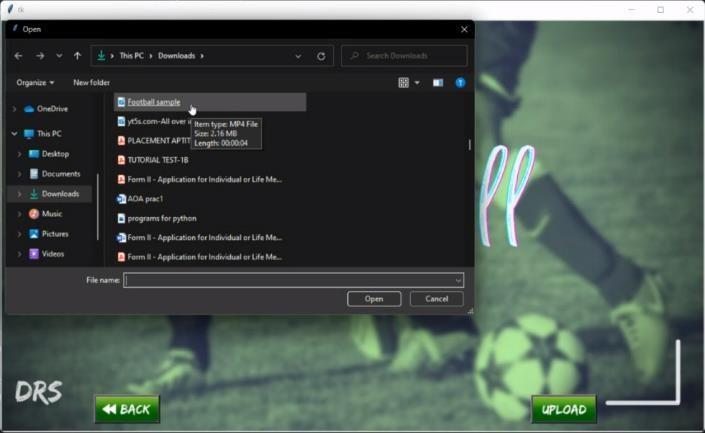
Figure6:SelecttheSportWindow
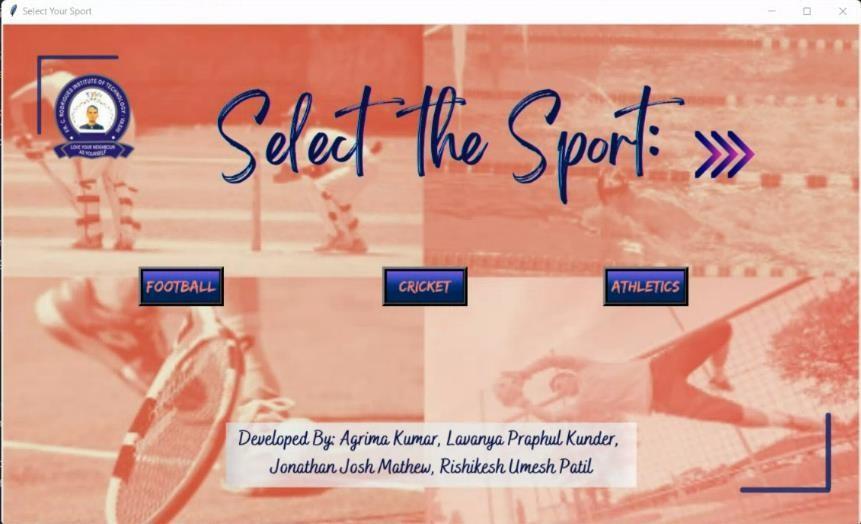



Supposeifthesportfootballis selected,itwilltakeusto thefootball window where the user can either go back whichwilltakethemorclickontheuploadbuttonwhere they canselect the appropriate file from their device’s memory.
On clicking upload, the user is directed to the main decision makingwindowwheretheycangoback tothe football window or manipulate the frame rate as going back 1FPS, 5FPS, 25FPS or moving forward 1FPS, 5FPS, 25FPS.Whenthedecisionhasbeenclearlyreflectedand theusersknowthedecision,theycanclickonproceed.
Figure9:Maindecision making window
Theuserthenproceedstogivedecisionaccordingly.
1.1 6.3 Important Code Snippet

Video=capturevideo fromfile;play(speed) { selectandimportvideo; Frame=getvideo'sfirstframe; Frame=setvideo's(first+speed) frame;grabbed; Frame=video.read; resizevideoaccordingto frame;resetcolorinRGB format;DisplayFramein canvas; }
7. CONCLUSION
Traditionallyinsports,thefinaljudgmentisgivenbythe referee. While usually most of these decisions are correct, often there are discrepancies behind these decisions since human judgment is involved which has thepotentialtochangethefinalresultofthegame.

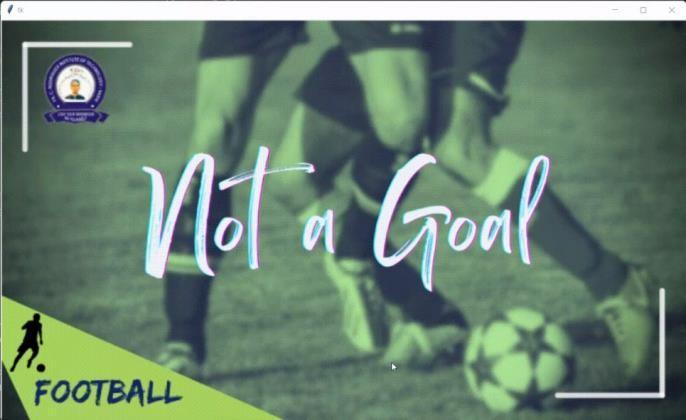

Hence, we have built a comprehensive approach to this problem which consists of a combination of various modulesand libraries in python that have been used to help create auser-friendly system which has a flexible and easy to use interface and enables the operator to give decisions. We understand that user of the system may not have technical expertise and therefore the system is designed in such a way that they are not burdened with technical jargon. This application works by altering the video speed and framerateand requires onlyagoodqualitycameratocapturethefeedthusgiving asenseoftechnologysimilartotheoneusedinsportsat professionallevels.
8. FUTURE SCOPE
At present, this system works when the exe. File alongwith pythonareinstalledinthedevice.Further, a feature of live
camera feed along with a website can be implemented for the module to work on devices whichdon’tnecessarilyhave
pythoninstalledinthem.
International Research Journal of Engineering and Technology (IRJET) e ISSN: 2395 0056

REFERENCES
[1]https://www.sportskeeda.com/cricket/decision review system explaining the technology behind it
[2]https://repository.cardiffmet.ac.uk/bitstream/h andle/10369/8744/HUNT%2C%20Mitchell%20Di ssertation.pdf?sequence=1&isAllowed=y
[3]https://en.wikipedia.org/wiki/Umpire_Decision _Review_System
[4]https://en.wikipedia.org/wiki/Hawk Eye
[5]Pallav Chaudhary, Gourang Ajmera, Saket Joshi. ‘Umpire Decision Review System in Cricket’ https://www.ijset.in/wp content/uploads/IJSET_V9_issue2_212.pdf
[6]N. Ancona, G. Cicirelli, A. Branca, A. Distante. ‘Goal detection in football by using Support Vector Machines for classification’ https://ieeexplore.ieee.org/document/939092/
[7]Mr. Mohnish Thandassery, Prof. Sarala Mary. ‘Use ofTechnologyinTennis,FootballandCricket’ https://www.irjet.net/archives/V6/i6/IRJET V6I6603.pdf
[8]P Nirmala devi, K Manoj Senthil, Selvavignesh. ‘Artificialintelligentthirdumpirerunoutdecision making using image processing’ https://www.researchgate.net/publication/34943 5248_Artificial_intelligent_third_umpire_runout_de cision_making_using_image_processing
[9]HarryCollinsandRobertEvans.‘You cannot be serious!Publicunderstandingoftechnologywith special reference to “HawkEye”’ https://journals.sagepub.com/doi/abs/10.1177/0 963662508093370
[10]AkhilRana.‘DecisionReviewSysteminCricket’ https://www.ijser.org/researchpaper/Decision Review System inCricket.pdf
Volume: 09 Issue: 05 | May 2022 www.irjet.net p ISSN: 2395 0072 © 2022, IRJET | Impact Factor value: 7.529 | ISO 9001:2008 Certified Journal | Page3599
